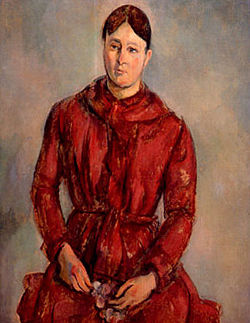
Marie-Hortense Fiquet
Encyclopedia

Model (art)
Art models are models who pose for photographers, painters, sculptors, and other artists as part of their work of art. Art models who pose in the nude for life drawing are usually called life models...
. She is best-known for her marriage to Paul Cézanne
Paul Cézanne
Paul Cézanne was a French artist and Post-Impressionist painter whose work laid the foundations of the transition from the 19th century conception of artistic endeavour to a new and radically different world of art in the 20th century. Cézanne can be said to form the bridge between late 19th...
and the 27 portraits, mostly in oil, he painted of her between 1869 and the late 1890s.
Life
She was born in SaligneySaligney
Saligney is a commune in the Jura department in the Franche-Comté region in eastern France.-Demographics:As of the census of 1999, the population was 153.The estimate for 2006 was 165.-References:*...
, France in April 1850. In 1869 she met Cézanne at an art school in Paris called Académie Suisse
Académie Suisse
The Académie Suisse was an art school founded by Charles Suisse, and was located at the corner of the Quai des Orfévres and the Boulevard du Palais, in Paris...
. This art school was used by a number of major artists as a place to meet each other and to paint the models who worked there. Fiquet's main job was as a bookseller or bookbinder, but she combined this with part-time work as a model. They started a relationship and when the Franco-Prussian War
Franco-Prussian War
The Franco-Prussian War or Franco-German War, often referred to in France as the 1870 War was a conflict between the Second French Empire and the Kingdom of Prussia. Prussia was aided by the North German Confederation, of which it was a member, and the South German states of Baden, Württemberg and...
broke out in 1870, they left Paris together for L'Estaque
L'Estaque
L'Estaque is a small French fishing village just west of Marseille. Administratively, it belongs to the commune of Marseille.Many artists of the Impressionist and Post-Impressionist periods visited or resided there or in the surrounding area. Many of them painted scenes of the village, the road...
in the south of France. Afraid of offending his father, Louis-Auguste Cézanne, a well-to-do banker, and compromising his allowance, he went to great lengths to conceal his liaison with Fiquet. The existence of their child Paul, born in 1872, was kept from Louis-Auguste for some years.
Fiquet and Cézanne married on 28 April 1886, in the presence of the artist's parents, though by that time he had publicly said that he no longer had any feelings for her. Described by one scholar as "high-maintenance", Fiquet was to live separately from her husband for much of their married life. After the death of Louis-Auguste Cézanne that same year, Cézanne and his wife separated, the artist moving in with his sister and mother and declaring, "My wife only cares for Switzerland and lemonade". The psychological distance between husband and wife appears to be reflected in the portraits where she gives the impression of being self-absorbed.
Although he continued to paint his wife until the 1890s, he disinherited her. Their one child, Paul (1872—1947) inherited his father's entire estate. The settlement that Hortense received from her son was squandered through gambling.
In literature
Hortense may have provided inspiration for a character in L'ŒuvreL'Œuvre
L'œuvre is the fourteenth novel in the Rougon-Macquart series by Émile Zola. It was first serialized in the periodical Gil Blas beginning in December 1885 before being published in novel form by Charpentier in 1886....
, an Émile Zola
Émile Zola
Émile François Zola was a French writer, the most important exemplar of the literary school of naturalism and an important contributor to the development of theatrical naturalism...
novel which appeared in serial form the year before the Cézannes' marriage. Zola was a friend to Cézanne since their schooldays. In the novel, Christine, also a model, marries a painter. However the book is not biographical in the strict sense; while the fictional painter bears some relation to Cézanne, Christine poses nude, a far cry from Cézanne's chaste portraits of Fiquet, and more reminiscent of Le déjeuner sur l'herbe by Édouard Manet
Édouard Manet
Édouard Manet was a French painter. One of the first 19th-century artists to approach modern-life subjects, he was a pivotal figure in the transition from Realism to Impressionism....
.
Sources
- Garb, Tamar. The Painted Face, Portraits of Women in France 1814-1914. Yale University Press, 2007. ISBN 978-0-300-11118-7
- Lindsay, Jack. Cézanne: His Life and Art. Greenwich, Connecticut: New York Graphic Society, 1969

